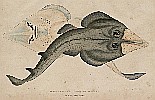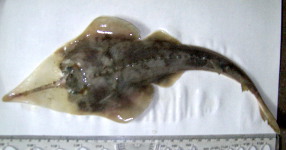Glaucostegus typus
(Bennett, 1830)
Classification: Elasmobranchii Rhinopristiformes Glaucostegidae
Reference of the original description
Class Pisces. In (Ed.), Memoir of the Life and Public Services of Sir Thomas Stamford Raffles (pp. 686–694), John Murray, London
Class Pisces. In (Ed.), Memoir of the Life and Public Services of Sir Thomas Stamford Raffles (pp. 686–694), John Murray, London
Synonyms / new combinations and misspellings
Glaucostegus cf. typus, Rhinobates batillum, Rhinobatos armatus, Rhinobatos batillium, Rhinobatos batillum, Rhinobatos typus, Rhinobatos typus batillum, Rhinobatos (Glaucostegus) typus, Rhinobatus armatus, Rhinobatus batillum, Rhinobatus typus, Rhinobatus (Rhinobatus) armatus
Glaucostegus cf. typus, Rhinobates batillum, Rhinobatos armatus, Rhinobatos batillium, Rhinobatos batillum, Rhinobatos typus, Rhinobatos typus batillum, Rhinobatos (Glaucostegus) typus, Rhinobatus armatus, Rhinobatus batillum, Rhinobatus typus, Rhinobatus (Rhinobatus) armatus
Types
Glaucostegus typus
Holotype: BMNH: 1852.8.30.17
Rhinobatos armatus
Holotype: BMNH: 1953.8.10.11
Glaucostegus typus
Holotype: BMNH: 1852.8.30.17
Rhinobatos armatus
Holotype: BMNH: 1953.8.10.11
Description :
Citation: Glaucostegus typus (Bennett, 1830): In: Database of modern sharks, rays and chimaeras, www.shark-references.com, World Wide Web electronic publication, Version 01/2026
Please send your images of "Glaucostegus typus" to info@shark-references.com

Glaucostegus typus (Bennett, 1830) © David Morgan, Freshwater Fish Group & Fish Health Unit, School of Veterinary & Life Sciences, Murdoch, Australia

Glaucostegus typus (Bennett, 1830) © David Morgan, Freshwater Fish Group & Fish Health Unit, School of Veterinary & Life Sciences, Murdoch, Australia
Common names
 Austalian guitarfish,
Austalian guitarfish,  Bennet"s shovelnose guitarfish,
Bennet"s shovelnose guitarfish,  Brown shovelnose ray,
Brown shovelnose ray,  Common shovelnose ray,
Common shovelnose ray,  Giant shovelnose ray,
Giant shovelnose ray,  Green shovelnose ray,
Green shovelnose ray,  Shovelnose ray,
Shovelnose ray,  Shovelnose shark
Shovelnose shark
 Austalian guitarfish,
Austalian guitarfish,  Bennet"s shovelnose guitarfish,
Bennet"s shovelnose guitarfish,  Brown shovelnose ray,
Brown shovelnose ray,  Common shovelnose ray,
Common shovelnose ray,  Giant shovelnose ray,
Giant shovelnose ray,  Green shovelnose ray,
Green shovelnose ray,  Shovelnose ray,
Shovelnose ray,  Shovelnose shark
Shovelnose shark
Distribution
Indo-West Pacific: Thailand to New Guinea and the Solomon Islands, south to Australia. Records from the south coast of India, Sri Lanka, Bangladesh, and Myanmar need confirmation. Source: www.gbif.org
Indo-West Pacific: Thailand to New Guinea and the Solomon Islands, south to Australia. Records from the south coast of India, Sri Lanka, Bangladesh, and Myanmar need confirmation. Source: www.gbif.org
Human uses
fisheries: minor commercial; aquarium: commercial; price category: low; price reliability: questionable: based on ex-vessel price for species in this genus
fisheries: minor commercial; aquarium: commercial; price category: low; price reliability: questionable: based on ex-vessel price for species in this genus
Biology
Exhibit ovoviparity (aplacental viviparity), with embryos feeding initially on yolk, then receiving additional nourishment from the mother by indirect absorption of uterine fluid enriched with mucus, fat or protein through specialised structures [733]. Born at 38-40 cm TL [2539]. Adults found on the continental shelf down to 100 m. Juveniles found inshore around atolls, in mangrove swamps and occasionally enter estuaries . Feeds on shellfish. Reported to live and breed permanently in freshwater.
Exhibit ovoviparity (aplacental viviparity), with embryos feeding initially on yolk, then receiving additional nourishment from the mother by indirect absorption of uterine fluid enriched with mucus, fat or protein through specialised structures [733]. Born at 38-40 cm TL [2539]. Adults found on the continental shelf down to 100 m. Juveniles found inshore around atolls, in mangrove swamps and occasionally enter estuaries . Feeds on shellfish. Reported to live and breed permanently in freshwater.
Remarks
shark-references Species-ID=2515; CITES: (see: Protected Species for more details) Convention on International Trade in Endangered Speciesof Wild Fauna and Flora annex: II; Council Regulation 2017/160 annex: B
shark-references Species-ID=2515; CITES: (see: Protected Species for more details) Convention on International Trade in Endangered Speciesof Wild Fauna and Flora annex: II; Council Regulation 2017/160 annex: B
Parasites (arranged by Jürgen Pollerspöck)
Myxosporea
Monogenea
Cestoda
Trematoda
Nematoda
Copepoda
Isopoda
Hirudinea
Myxosporea
- Kudoa hemiscylli Gleeson, Bennett & Adlard, 2010 [21484]
Monogenea
- Calicotyle australis Johnston, 1934 [17453] [17436] [11283]
- Dermopristis cairae Whittington & Kearn, 2011 [13610] [15234] [33501]
- Mycteronastes icopae (Beverley-Burton & Williams, 1989) [17044] [17438] [24082] [17002] [10849] [23992] [15261] [21453] [10850] [21289] [15785] [25877] [29167]
- Neoheterocotyle rhinobatidis (Young, 1967) Chisholm, 1994 [17439] [17441] [24082] [21422] [23992] [21453]
- Neoheterocotyle rhynchobatis (Tripathi, 1959) Chisholm, 1994 [17439] [23992] [21453] [29167]
- Troglocephalus rhinobatidis Young, 1967 [17104] [11678] [17438] [24082] [10849] [21422] [23992] [15261] [21453] [29167]
Cestoda
- Balanobothrium rhinobati Jadhav & Shinde, 1982 [16329]
- Balanobothrium somnathai Jadhav & Shinde, 1982 [16329]
- Balanobothrium veravalensis Jadhav & Shinde, 1979 [16160]
- Dollfusiella spinosa Schaeffner & Beveridge, 2013 [19694] [21816]
- Dollfusiella spinulifera (Beveridge & Jones, 2000) [7371] [16112] [14409] [14410] [15747]
- Echinobothrium chisholmae Jones & Beveridge, 2001 [7379] [16430] [15747] [15660] [19536] [19536]
- Echinobothrium rhynchobati (Khalil & Abdul-Salam, 1989) [16430] [15747] [19536] [19536]
- Echinobothrium tetabuanense Ivanov & Caira, 2012 [15660] [19536]
- Echinobothrium weipaense Ivanov & Caira, 2012 [15660] [19536]
- Floriparicapitus plicatilis Cielocha, Jensen & Caira, 2014 [21566] [23959]
- Parachristianella baverstocki Beveridge, 1990 [21816]
- Parachristianella indonesiensis Palm, 2004 [21816]
- Parachristianella monomegacantha Kruse, 1959 [21816]
- Prochristianella aciculata Beveridge & Justine, 2010 [17404]
- Prochristianella clarkeae Beveridge, 1990 [17404]
- Scalithrium healyae Volin, Caira & Bueno, 2024 [34208]
- Scalithrium johnvolini Volin, Caira & Bueno, 2024 [34208]
- Stillabothrium amuletum (Butler, 1987) [13130] [24898]
Trematoda
- Myliobaticola sp. [25781]
- Neoheterocotyle rhinobatidis (Young, 1967) Chisholm, 1994 [17104] [11678] [17438] [10849] [15261] [10850]
- Ogawaia glaucostegi Cutmore, Cribb & Yong, 2018 [26748] [28146]
Nematoda
Copepoda
- Caligus furcisetifer Redkar, Rangnekar & Murti, 1949 [26229] [33501]
- Lepeophtheirus acutus Heegaard, 1943 [13845]
- Tripaphylus australis (Kabata, 1993) [17875]
Isopoda
- Argathona lebara Longstaff, Bruce, Smit & Hadfield, 2025 [35359]
Hirudinea


















